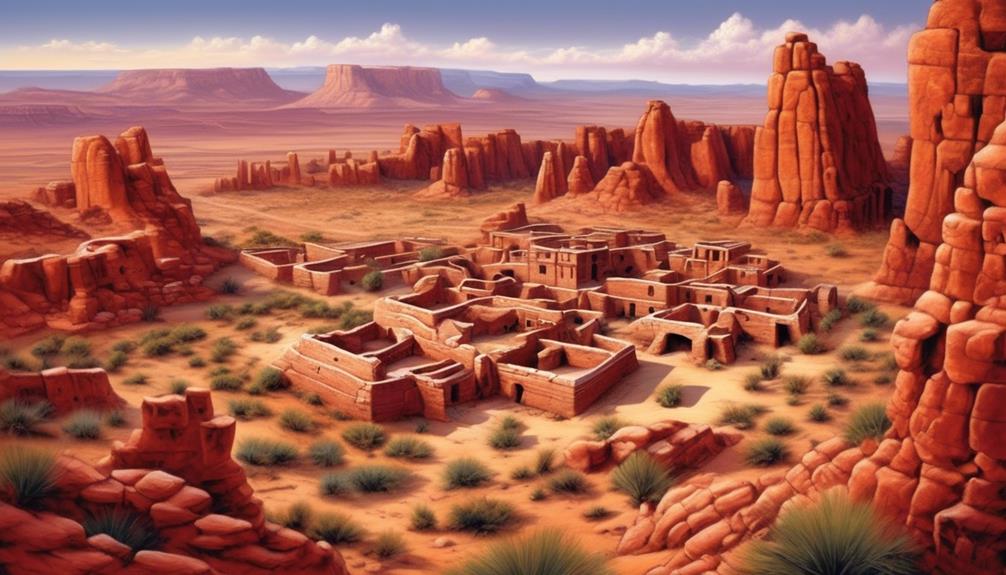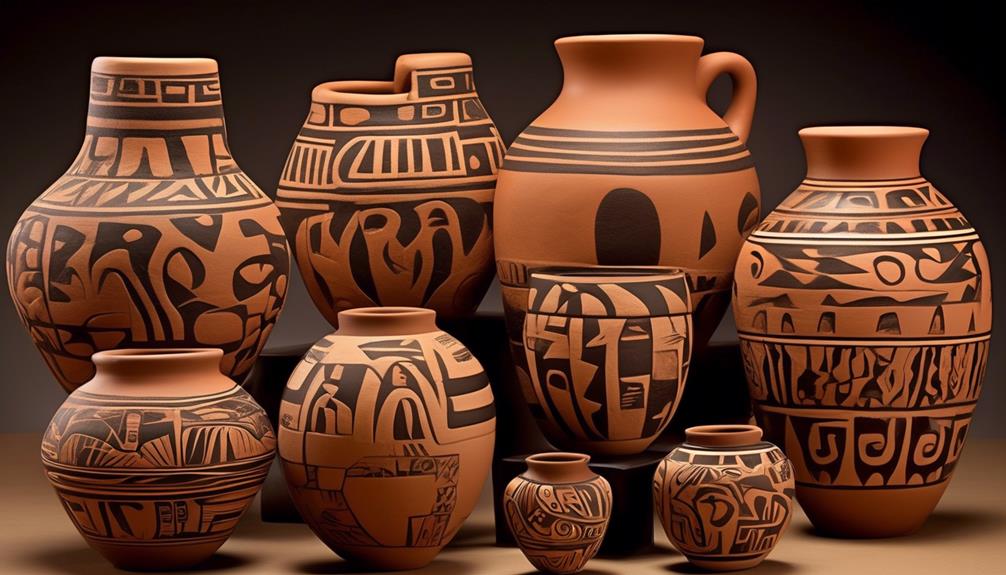While standing on the ancient red rock formations of the American Southwest, one is inevitably drawn to contemplate the origins of the Hopi tribe, a group whose history is just as enigmatic and complex as the surrounding landscape.
The Hopi's journey through time is a tapestry woven with threads of oral tradition, archeological evidence, and a deep connection to their ancestral lands.
The question of where the Hopi tribe originated from is a complex one, encompassing various theories and perspectives that continue to captivate scholars and enthusiasts alike.
Key Takeaways
- Hopi migration patterns have been extensively studied, and genetic evidence has been used to trace their origins and movements.
- Hopi oral traditions and legends deeply rooted in cultural beliefs provide insights into their origins and interactions with other tribes.
- Archeological findings and genetic research support the long-standing presence of the Hopi in the northern Arizona region and their genetic continuity with ancient ancestors.
- The Hopi people have a strong ancestral connection to the land, with specific sacred sites and geographical features shaping their cultural beliefs and identity.
Ancient Hopi Migration Theories
Ancient Hopi migration theories propose various explanations for the origins and movements of the Hopi tribe across the American Southwest. Hopi migration patterns have been the subject of extensive study, with researchers using a variety of methods to uncover the tribe's ancestral movements. One significant approach has been the use of genetic evidence to trace the origins of the Hopi people and their migration routes. Genetic studies have provided valuable insights into the ancestral connections of the Hopi tribe, shedding light on their migration patterns and historical relationships with other indigenous groups in the Southwest.
Comparative analysis of genetic data from the Hopi tribe and other Native American populations has enabled researchers to identify commonalities and differences, thereby contributing to a deeper understanding of the tribe's migration history. By examining genetic markers and tracing their distribution, scientists have been able to construct plausible migration scenarios, enriching our knowledge of the Hopi people's ancestral movements.
These findings haven't only enhanced our comprehension of Hopi migration patterns but also deepened our appreciation of the intricate tapestry of indigenous history in the American Southwest.
Hopi Oral Traditions and Legends

Drawing from a rich tapestry of oral traditions and legends, the Hopi tribe offers profound insights into their cultural heritage and historical narratives.
- Cultural Beliefs: Hopi oral traditions are deeply rooted in their cultural beliefs, shaping their worldview and guiding their way of life. These oral narratives provide a glimpse into the Hopi understanding of the universe, human existence, and the interconnectedness of all things.
- Mythical Stories: The Hopi oral traditions are replete with mythical stories that have been passed down through generations. These stories often feature legendary figures and supernatural beings, offering valuable lessons and moral teachings for the community.
- Creation Tales: Central to Hopi oral traditions are creation tales that explain the origins of the world and the emergence of the Hopi people. These narratives provide a unique perspective on the creation of the earth, the birth of humankind, and the formation of the Hopi society.
- Historical Narratives: Through their oral traditions, the Hopi preserve historical narratives that recount significant events, migrations, and interactions with neighboring tribes. These narratives serve as a vital repository of the tribe's collective memory and historical consciousness.
- Comparative Insights: By delving into Hopi oral traditions and legends, one can gain comparative insights into the ways different cultures construct and transmit their foundational stories, beliefs, and historical knowledge.
Archeological Evidence of Hopi Origins
Archeological evidence sheds light on the origins of the Hopi tribe, providing valuable insights into their early settlements and cultural development. Archeological findings indicate that the ancestors of the Hopi people have inhabited the northern Arizona region for over a millennium. Excavations at sites such as Homol'ovi and Awatovi have unearthed artifacts, architecture, and pottery that are characteristic of the Hopi culture. These findings suggest a long-standing presence and a rich cultural heritage in the region.
Moreover, genetic research has contributed to the understanding of the Hopi origins. Studies of DNA lineages have provided evidence of the genetic continuity of the Hopi people with their ancient ancestors. This research has revealed connections between modern Hopi individuals and the ancestral Puebloans, further supporting the enduring presence of the Hopi people in the region.
Comparatively, the archeological evidence and genetic research align with the oral traditions and legends of the Hopi tribe, collectively contributing to a comprehensive understanding of their origins. Together, these sources provide a compelling narrative of the Hopi people's enduring connection to their ancestral lands and the development of their unique cultural traditions.
The Hopi Ancestral Connection to the Land

Our understanding of the Hopi tribe's enduring presence and cultural heritage is closely intertwined with their ancestral connection to the land. The Hopi people have deep ancestral ties to the land, and this connection holds immense cultural significance for their community.
Here are some key aspects of the Hopi ancestral connection to the land:
- Sacred Sites: The Hopi people have identified specific places within their ancestral lands as sacred sites, each holding spiritual significance and playing a crucial role in their ceremonial practices.
- Agricultural Traditions: The landscape of the Hopi ancestral lands has shaped their agricultural practices, with farming methods and crop selection influenced by the unique environmental conditions and resources available.
- Mythological Landscape: The Hopi oral tradition is rich with stories that link specific geographical features to their cultural beliefs, creating a mythological landscape that reinforces their ancestral ties to the land.
- Sustenance and Survival: The land has provided the Hopi people with sustenance and resources for countless generations, forming the basis of their traditional lifestyle and sustaining their community.
- Interconnectedness: The Hopi ancestral connection to the land emphasizes the interconnectedness of their cultural, spiritual, and physical existence, shaping their identity and way of life.
Contemporary Perspectives on Hopi Origins
How do contemporary perspectives shed light on the origins of the Hopi tribe?
Genetic evidence plays a significant role in understanding the ancestral origins of the Hopi people. Recent studies have employed genetic analysis to trace the migratory patterns and origins of Native American tribes, including the Hopi. These studies provide valuable insights into the genetic connections between the Hopi and other indigenous groups, shedding light on their ancient origins and migration routes. By examining the genetic markers and variations present in the Hopi population, researchers can identify links to specific ancestral populations and geographical regions. This genetic evidence contributes to a more comprehensive understanding of the Hopi tribe's origins and their historical connections to other Native American groups.
In addition to genetic evidence, contemporary perspectives also consider the Hopi tribe's cultural identity. The preservation of oral histories, traditional practices, and ceremonial rituals among the Hopi people provides important cultural insights that complement genetic findings. By integrating genetic evidence with cultural identity, contemporary perspectives offer a more holistic understanding of the Hopi tribe's origins, enriching our knowledge of their ancestral heritage.
Frequently Asked Questions
What Impact Did the Ancient Hopi Migration Have on Neighboring Tribes and Cultures?
The ancient Hopi migration had a significant impact on neighboring tribes and cultures. Genetic studies have shown the ancestral connection between the Hopi and other indigenous groups, indicating shared lineage and cultural exchange.
This migration influenced neighboring tribes through the diffusion of agricultural techniques, religious practices, and artistic traditions. The cultural exchange fostered a rich tapestry of interconnected traditions and beliefs among the indigenous peoples of the region.
How Have Modern Genetic Studies Contributed to Our Understanding of the Hopi Tribe's Origins?
Genetic studies have revolutionized our understanding of the Hopi tribe's origins. By analyzing DNA, we've unraveled the complex web of ancestral migration patterns that shaped the Hopi's cultural practices.
These studies provide insight into the environmental impact of these movements, shedding light on how the tribe adapted to diverse landscapes.
Through this lens, we gain a deeper appreciation for the resilience and resourcefulness of the Hopi people throughout history.
Are There Any Specific Rituals or Ceremonies That the Hopi Tribe Practices to Honor Their Ancestral Connection to the Land?
We honor our ancestral connection to the land through sacred ritual practices and ceremonies.
These ceremonies are deeply intertwined with our tribal origins, serving as a way for us to maintain a strong connection to our heritage and the land we call home.
The rituals and ceremonies are a testament to our enduring cultural traditions and the profound respect we hold for our ancestral lands.
How Have Environmental Changes Over Time Affected the Hopi Tribe's Connection to Their Ancestral Lands?
Environmental changes have challenged the Hopi tribe's ancestral connection to their lands. Our agricultural practices, like dry farming, have required adaptation to shifting climate patterns.
We've implemented water conservation strategies and diversified crops to preserve our cultural heritage. As stewards of the land, we continuously seek sustainable solutions to honor our traditions while navigating environmental challenges.
This balance between environmental adaptation and cultural preservation is crucial for our tribe's resilience and longevity.
What Role Do Oral Traditions and Legends Play in Shaping the Contemporary Perspectives of the Hopi Tribe's Origins?
Oral traditions are integral to shaping our cultural identity. They provide a link to our ancestors and foster a sense of belonging.
Historical evidence and archaeological findings complement these narratives, offering a comprehensive understanding of our origins. By comparing oral traditions with empirical data, we gain a deeper insight into our history.
It's a fascinating blend of storytelling and scientific exploration that enriches our perspective on the Hopi tribe's origins.
Conclusion
In conclusion, the origins of the Hopi tribe remain shrouded in mystery. There are various theories that attempt to explain their ancient migration, including oral traditions and archeological evidence. Additionally, the ancestral connection to the land also offers insights into their origins.
As we navigate through the layers of time and history, it becomes clear that the Hopi people's origins are multifaceted. The juxtaposition of these varied viewpoints paints a complex and rich tapestry of their cultural heritage. It reminds us of the depth and diversity of the Hopi tribe's origins, further emphasizing the significance of their history.









